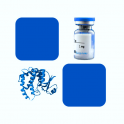
- Remove this product from my favorite's list.
- Add this product to my list of favorites.
Products
Newsletter
 |  |  |  |  |  |

Background
Folate Receptor 1 (FOLR1) is also known as Folate receptor alpha, Folate Binding Protein (FBP), FOLR, and is a member of the folate receptor (FOLR) family. Members of this gene family have a high affinity for folic acid and for several reduced folic acid derivatives, and mediate delivery of 5-methyltetrahydrofolate to the interior of cells. Mature FOLR1 is an N-glycosylated protein that is anchored to the cell surface by a GPI linkage. FOLR1 is predominantly expressed on epithelial cells and is dramatically upregulated on many carcinomas. FOLR1 is internalized to the endosomal system where it dissociates from its ligand before recycling to the cell surface. A soluble form of FOLR1 can be proteolytically shed from the cell surface into the serum and breast milk. Defects in FOLR1 are the cause of neurodegeneration due to cerebral folate transport deficiency (NCFTD). NCFTD is an autosomal recessive disorder resulting from brain-specific folate deficiency early in life.
Source
Recombinant Biotinylated Human FOLR1, His,Avitag (FO1-H82E2) is expressed from human 293 cells (HEK293). It contains AA Arg 25 - Met 233 (Accession # P15328-1).
Predicted N-terminus: Arg 25
Molecular Characterization
This protein carries a polyhistidine tag at the C-terminus, followed by an Avi tag.
The protein has a calculated MW of 28.3 kDa. The protein migrates as 35-45 kDa under reducing (R) condition (SDS-PAGE) due to glycosylation.
Biotinylation
Biotinylation of this product is performed using Avitag™ technology. Briefly, the single lysine residue in the Avitag is enzymatically labeled with biotin.
Biotin:Protein Ratio
Passed as determined by the HABA assay / binding ELISA.
Endotoxin
Less than 1.0 EU per μg by the LAL method.
Purity
>95% as determined by SDS-PAGE.
>90% as determined by SEC-MALS.
Formulation
Lyophilized from 0.22 μm filtered solution in PBS, pH7.4. Normally trehalose is added as protectant before lyophilization.
Reconstitution
Please see Certificate of Analysis for specific instructions.
For best performance, we strongly recommend you to follow the reconstitution protocol provided in the CoA.
Storage
For long term storage, the product should be stored at lyophilized state at -20°C or lower.
Please avoid repeated freeze-thaw cycles.
This product is stable after storage at:
-20°C to -70°C for 12 months in lyophilized state;
-70°C for 3 months under sterile conditions after reconstitution.
Bioactivity
Please refer to product data sheet.
(1) "Cerebral folate deficiency: A report of two affected siblings"
Almahmoud, Mekki, El-Hattab
Mol Genet Metab Rep (2023) 35, 100975
(2) "Targeted plasma proteomics identifies MICA and IL1R1 proteins associated with HIV-1 reservoir size"
Blaauw, Cristina Dos Santos, Vadaq et al
iScience (2023) 26 (4), 106486
(3) "FOLR1-induced folate deficiency reduces viral replication via modulating APOBEC3 family expression"
Wu, Han, Lyu et al
Virol Sin (2023)
Showing 1-3 of 345 papers.
Follow us